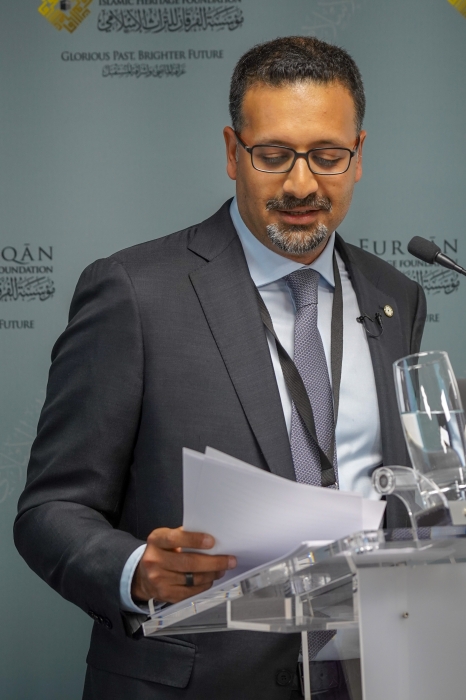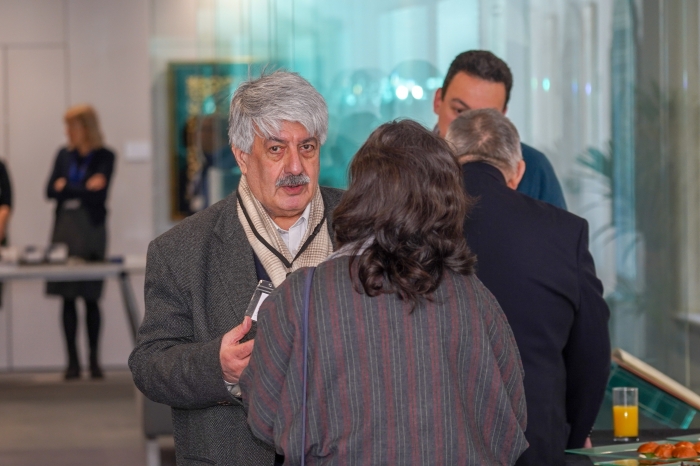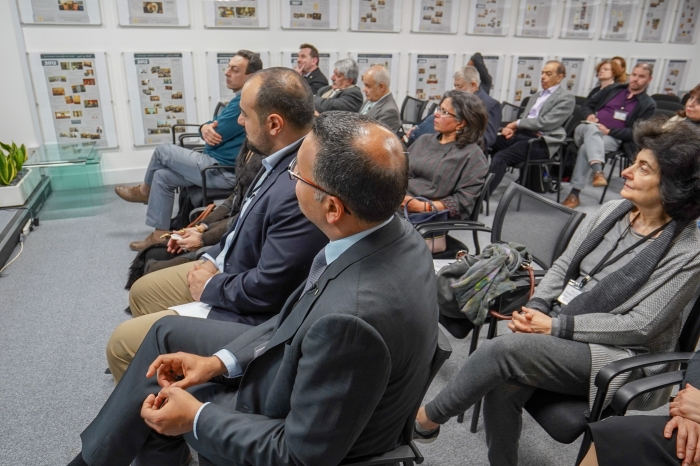“The Maghrib in the Mashriq”, Lecture by Prof. Maribel Fierro
As part of its seasonal lecture series, Al-Furqān Islamic Heritage Foundation organised a public lecture on Wednesday, 3 April 2019. The lecture was titled, “The Maghrib in the Mashriq”, and was hosted at the lecture theatre in Al-Furqān’s London headquarters. The lecturer was Professor Maribel Fierro, Research Professor at the Institute of Languages and Cultures of the Mediterranean (CSIC – Spain).

Mr Tariq al-Timimi, in charge of the Content & Editing at the Foundation, opened the evening by welcoming and thanking the guests, before inviting Mr Sharaf Yamani, Member of the Board of Directors of Al-Furqān, to deliver some opening remarks.
Mr Yamani began by extending a warm welcome from the Chairman of the Foundation, Sheikh Ahmed Zaki Yamani. He then introduced the topic of the lecture, saying that: “Whether one regards it as an historical period or a geographic area, the Andalus is widely held as one of the most important chapters in humanity. Indeed, many historians consider it the true golden age of Muslim civilisation and one that gave birth to unparalleled contributions in the world of arts and culture, science and medicine, law, and indeed love and war”.
With Al-Andalus’s enduring legacy, we continue to see the fruitful contributions made in that world—a world that has earned a somewhat mythical status, a dreamland culture of sorts—in which, he said, “members of three religious communities—Jew, Christian and Muslim—collectively created a culture in which they lived in common, and to which they contributed.”
In light of this, Mr Yamani highlighted that the Al-Furqān Islamic Heritage Foundation itself has recently undertaken the editing and publication of major contributions from al-Andalus, such as the Ibn ʿAbdul-Barr’s hadithcommentary work, al-Tamhīd, and, he ended by giving the audience the glad tidings that the Foundation will soon be publishing al-Tamhīd’s sister-work, al-Istidhkār.
Following Mr Yamani’s opening comments, Mr al-Timimi gave some words of introduction regarding the guest speaker. He highlighted the facts that: Professor Fierro has devoted the majority of her academic work to the study and unearthing of all that relates to the Andalus. She has written extensively on the political, religious, and intellectual history of al-Andalus and the Islamic West, and on Islamic - particularly Mālikī - law, among many other topics. She has published critical editions of Andalusian works, and has written substantially on Ibn Rushd’s Bidāyat al-Mujtahidand the Almohad pedagogical project. He ended by sharing an anecdote: in a copy of the late Moroccan ʿAllama Muhammad Bensharifa’s book, Ibn Rushd: Sīrah Wathāʾiqiyyah, he had stumbled across his dedication to Dr Fierro, whom he referred to as, “sultānat al-ʿilm wal-baḥth” (the Sultana of scholarship and research).
Professor Fierro’s talk was divided into three parts: firstly, a broad overview of the Maghrib in relation to the Mashriq: geography, politics and representation; secondly: the Maghrib in the Mashriq: the ‘best-sellers’, and finally, ‘How and why works produced in the Maghrib or written by Maghribis made it in the Mashriq’. Each of these subthemes was detailed at length, with the provision of further references and studies for those interested. One of the significant conclusions found, based on data analysis of a huge number of extant biographical works, is that Maghribis were noted for their keen interest in Qur’anic modes of recitation, the writing of texts on creed (an almost exclusively Andalusian genre at one point) and Sufism.
Moving on to the ‘best-seller’ list (those books which had been most copied, cited, abridged, commented on and possibly plagiarised), Professor Fierro highlighted the top ten Andalusian works that have been found elsewhere in the Muslim world, including the number of manuscripts found of each. These top ten books, were, in order:
1. al-Shifāʼby Qāḍī ʽIyāḍ (d. 544/1149)
2. Ḥirz al-amānī fī wajh al-tahānīoral-Qaṣīda al-shāṭibiyyaby al-Shāṭibī (538/1143-590/1194)
3.al-Alfiyyaby Ibn Mālik (d. 672/1274)
4.Kitāb al-jāmiʽ li-mufradāt al-adwiya wa-l-aghdhiyaby Ibn al-Bayṭār (576/1180 or 583/1187-646/1248)
5. Rutbat al-ḥakīmby Maslama b. Qāsim (295/908-353/964)
6. al-Jāmiʽ li-aḥkām al-Qurʼānby al-Qurṭubī (d. 671/1273)
7.Kashf al-asrār ʽan ilm (ḥurūf) al-ghubārby al-Qalaṣādī (¿815/1412?-891/1486)
8. Sirāj al-mulūkby al-Ṭurṭūshī (c. 451/1059-520/1126
9. Urjūzat al-wildānor al-Muqaddima al-qurṭubiyya
10.al-Ājurrūmiyyaby Ibn Ājurrūm (672/1273-723/1323)
The above showed that the Andalusian best-sellers focused on the Qur’an, the Prophetic biography, books on creed and the basic pillars of Islam, grammar, medicine, mathematics, literature and politics. Based on statistical figures, Professor Fierro was able to demonstrate with figures that around three centuries into the conquest of Andalus (711), the works found to be circulating in the Andalus were overwhelmingly legal writings and books of poetry; however, what was peculiar, perhaps, was that, of the ten best-sellers, six were written in the 12th-13thcenturies under Almoravid and Almohad rule. Besides this, she noted how four Almohad scholars earned huge fame in the Mashriq, namely, Ibn Tufayl (d. 581/1185), Averroes (d. 595/1198), Maimonides (d.1204) and Muḥyī al-Dīn Ibn ʿArabī (d. 638/1240).
She ended by highlighting that works produced during this period - some best-sellers themselves - were marked by their encyclopaedism and their reliance on didactic poems. The motive behind this particular style however was that the Almohad’s were interested in creating for themselves credible religious authority, and to train a new class of students and heirs of future rule.
The lecture concluded with a very engaging question and answer session.
Maribel Fierro (Ph.D., University Complutense of Madrid) is Research Professor at the Institute of Languages and Cultures of the Mediterranean (CSIC – Spain). She has worked and published on the political, religious and intellectual history of al-Andalus and the Islamic West, Islamic law, the construction of orthodoxy and the persecution of heresies, and violence and its representation in Medieval Arabic sources. Her standing research projects are: Practicing knowledge in Islamic societies and their neighbours(Anneliese Maier Award 2014, Alexander von Humboldt Foundation) and Local contexts and global dynamics: al-Andalus and the Maghreb in the Islamic East(with Mayte Penelas, financed by the Spanish Ministry of Education). Among her publications: The Almohad revolution. Politics and religion in the Islamic West during the twelfth-thirteenth centuries(2012), and Abd al-Rahman III: The first Cordoban caliph(2005). She is the editor of volume 2 (The Western Islamic world, eleventh-eighteenth centuries) of The New Cambridge History of Islam(2010); with C. Adang and S. Schmidtke, Ibn Hazm of Cordoba: The Life and Works of a Controversial Thinker(2012); Orthodoxyand heresy in Islam: Critical Concepts in Religious Studies(2013); with J. Tolan, The legal status of Ḏimmī‑s in the Islamic West(2013) and with H. Ansari, C. Adang and S. Schmidtke of Accusations of unbelief in Islam: A diachronic perspective on takfir (2015).
Related Video






